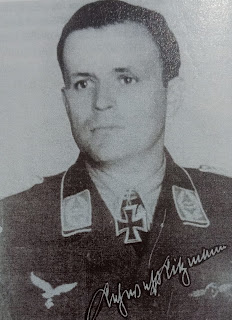Fritz Engau was a Bf 110 Nachtjagd pilot who flew with Schnaufer in NJG 1 before joining JG 11 in the defence of the Reich. His memoir - 'Frontal durch die Bomberpulks' - is a rather poorly organised and photographically weak account but then memoirs from Focke Wulf 190 pilots and in this instance a JG 11 Staffelführer in the defence of the Reich are rather thin on the ground.
Engau provides a fairly detailed bio on page 11 of his book. He went to flying school with Schnaufer. He was promoted to Leutnant on 1 April 1941, and to Oberleutnant on 1 April 1943. He first served in II./NJG 1 (again with Schnaufer), where he led 5. Staffel. On May 30, 1943 he was WIA after the engines of his Bf 110 G-4 (G9+FN) were hit by enemy fire. He bailed out near Glimmes, 17 km SSW of Tirlemont/Belgium. After his convalescence, he was appointed Staffelkapitän of 2./JG 11 during May 1944 and promoted to Oblt. On several occasions, he assumed acting command of the Gruppe (I./JG 11) and the Geschwader. He claimed one Viermot and three P-51s and damaged a B-17, all between 29 April 1944 and 7 June 1944 (his 1st, a B-17 at Nienburg on 29 April, 1944. His 2nd, a P-51 SW of Walsrode on 8 May, 1944. His 3rd, a P-51 NE of Kiel on 19 May, 1944. His 4th, a B-17 (HSS) at Müritz on 29 May, 1944. His 5th, a P-51 at Wald by Rambouillet on 7 June, 1944). Some sources credit him with two RAF bombers with NJG 1 giving him seven victories. He was badly injured in a crash landing at Rennes on 15 June 1944 in Fw 190 A-7 'black 1' (WNr. 643701)and sent home the next month. Prien describes him as one of the "experienced and successful Staffel leaders who formed the backbone of the flying organizations".
In 'Frontal durch die Bomberpulks' - sub-titled '1944 Reichsverteidigung - Normandie-Invasion: Deutsche Jadgflieger in ihren schwersten Kämpfen' or German fighter pilots in their hardest combats - Engau describes his experiences in 1944 over the Reich and the Normandy invasion front. Engau recalled one of his most notable sorties. On May 24, 1944 616 Fortresses of 1 and 3 BD escorted by over 900 fighters headed for Berlin crossing the coast from the north over Schleswig-Holstein. Some 14 Tagjagd Gruppen were directed against this raid including Engau’s I./JG 11;
“..it was one of the sorties I flew as a day fighter that I would never forget. We could only fly the occasional mission in the kind of poor visibility we met that day. We were about ten Fw 190s and we flew in an arrow-head formation. We managed to turn into a box of two or three Pulks – each of 18 bombers - but were not quite correctly lined up on them. With Oblt. (Hans-Heinrich) Koenig leading we headed towards the formation all guns blazing. Suddenly there was a flash. Koenig had failed to pull up in time and had smashed full tilt into a B-17. The bright explosion was probably his explosive rounds going off. I saw huge pieces of debris spinning away. As we passed through the Pulk and swept into a turn to fly a second pass there was no sign of the B-17 that had been hit. But I could still see the wreck of Koenig’s machine tumbling down, wings torn off. It was not burning ..but there was no parachute..”

















